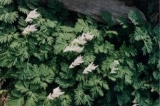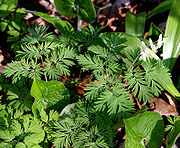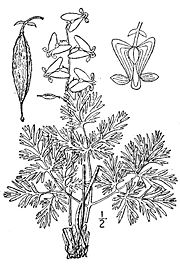
Dicentra cucullaria
Encyclopedia
Dicentra cucullaria is a perennial
herbaceous
plant
, native to rich woods of eastern North America
, with a disjunct population
in the Columbia River
Basin
.
The common name Dutchman's breeches derives from their white flowers that look like white breeches
.
 Height is 15-40 cm. Root
Height is 15-40 cm. Root
is a cluster of small pink to white teardrop
-shaped bulb
lets. Leaves
are 10-36 cm long and 4-18 cm broad, with a petiole up to 15 cm long; they are trifoliate, with finely divided leaflets.
Flower
s are white, 1-2 cm long, and are born in spring on flower stalks 12-25 cm long.
Dutchman's breeches is one of many plants whose seeds are spread by ants, a process called myrmecochory
. The seeds have a fleshy organ called an elaiosome
that attracts ants. The ants take the seeds to their nest, where they eat the elaiosomes, and put the seeds in their nest debris, where they are protected until they germinate. They also get the added bonus of growing in a medium made richer by the ant nest debris.
The western populations have sometimes been separated as Dicentra occidentalis on the basis of often somewhat coarser growth, but do not differ from many eastern plants in the Appalachians.

 Native Americans
Native Americans
and early white practitioners considered this plant useful for syphilis
, skin conditions and as a blood purifier. Dutchman's breeches contains several alkaloids that may have effects on the brain and heart.
However, D. cucullaria may be toxic and causes contact dermatitis
in some people.
Perennial plant
A perennial plant or simply perennial is a plant that lives for more than two years. The term is often used to differentiate a plant from shorter lived annuals and biennials. The term is sometimes misused by commercial gardeners or horticulturalists to describe only herbaceous perennials...
herbaceous
Herbaceous plant
A herbaceous plant is a plant that has leaves and stems that die down at the end of the growing season to the soil level. They have no persistent woody stem above ground...
plant
Flowering plant
The flowering plants , also known as Angiospermae or Magnoliophyta, are the most diverse group of land plants. Angiosperms are seed-producing plants like the gymnosperms and can be distinguished from the gymnosperms by a series of synapomorphies...
, native to rich woods of eastern North America
North America
North America is a continent wholly within the Northern Hemisphere and almost wholly within the Western Hemisphere. It is also considered a northern subcontinent of the Americas...
, with a disjunct population
Disjunct distribution
In biology, a taxon with a disjunct distribution is one that has two or more groups that are related but widely separated from each other geographically...
in the Columbia River
Columbia River
The Columbia River is the largest river in the Pacific Northwest region of North America. The river rises in the Rocky Mountains of British Columbia, Canada, flows northwest and then south into the U.S. state of Washington, then turns west to form most of the border between Washington and the state...
Basin
Drainage basin
A drainage basin is an extent or an area of land where surface water from rain and melting snow or ice converges to a single point, usually the exit of the basin, where the waters join another waterbody, such as a river, lake, reservoir, estuary, wetland, sea, or ocean...
.
The common name Dutchman's breeches derives from their white flowers that look like white breeches
Breeches
Breeches are an item of clothing covering the body from the waist down, with separate coverings for each leg, usually stopping just below the knee, though in some cases reaching to the ankles...
.

Root
In vascular plants, the root is the organ of a plant that typically lies below the surface of the soil. This is not always the case, however, since a root can also be aerial or aerating . Furthermore, a stem normally occurring below ground is not exceptional either...
is a cluster of small pink to white teardrop
Teardrop
Teardrop may refer to:* Tears, a liquid produced in the eyes for cleaning and lubricating* Teardrop attacks, a remote denial-of-service attack * Teardrop trailer, a type of travel trailer* Teardrop hull, a submarine hull design...
-shaped bulb
Bulb
A bulb is a short stem with fleshy leaves or leaf bases. The leaves often function as food storage organs during dormancy.A bulb's leaf bases, known as scales, generally do not support leaves, but contain food reserves to enable the plant to survive adverse conditions. At the center of the bulb is...
lets. Leaves
Leaf
A leaf is an organ of a vascular plant, as defined in botanical terms, and in particular in plant morphology. Foliage is a mass noun that refers to leaves as a feature of plants....
are 10-36 cm long and 4-18 cm broad, with a petiole up to 15 cm long; they are trifoliate, with finely divided leaflets.
Flower
Flower
A flower, sometimes known as a bloom or blossom, is the reproductive structure found in flowering plants . The biological function of a flower is to effect reproduction, usually by providing a mechanism for the union of sperm with eggs...
s are white, 1-2 cm long, and are born in spring on flower stalks 12-25 cm long.
Dutchman's breeches is one of many plants whose seeds are spread by ants, a process called myrmecochory
Myrmecochory
Myrmecochory is seed dispersal by ants, an ecologically significant ant-plant interaction with worldwide distribution. Myrmecochorous plants produce seeds with elaiosomes, a term encompassing various external appendages or "food bodies" rich in lipids, amino acid, or other nutrients that are...
. The seeds have a fleshy organ called an elaiosome
Elaiosome
Elaiosomes are fleshy structures that are attached to the seeds of many plant species. The elaiosome is rich in lipids and proteins, and may be variously shaped. Many plants have elaiosomes to attract ants, which take the seed to their nest and feed the elaiosome to their larvae...
that attracts ants. The ants take the seeds to their nest, where they eat the elaiosomes, and put the seeds in their nest debris, where they are protected until they germinate. They also get the added bonus of growing in a medium made richer by the ant nest debris.
The western populations have sometimes been separated as Dicentra occidentalis on the basis of often somewhat coarser growth, but do not differ from many eastern plants in the Appalachians.

Medical uses

Indigenous peoples of the Americas
The indigenous peoples of the Americas are the pre-Columbian inhabitants of North and South America, their descendants and other ethnic groups who are identified with those peoples. Indigenous peoples are known in Canada as Aboriginal peoples, and in the United States as Native Americans...
and early white practitioners considered this plant useful for syphilis
Syphilis
Syphilis is a sexually transmitted infection caused by the spirochete bacterium Treponema pallidum subspecies pallidum. The primary route of transmission is through sexual contact; however, it may also be transmitted from mother to fetus during pregnancy or at birth, resulting in congenital syphilis...
, skin conditions and as a blood purifier. Dutchman's breeches contains several alkaloids that may have effects on the brain and heart.
However, D. cucullaria may be toxic and causes contact dermatitis
Dermatitis
-Etymology:Dermatitis derives from Greek derma "skin" + -itis "inflammation" and genetic disorder.-Terminology:There are several different types of dermatitis. The different kinds usually have in common an allergic reaction to specific allergens. The term may describe eczema, which is also called...
in some people.

